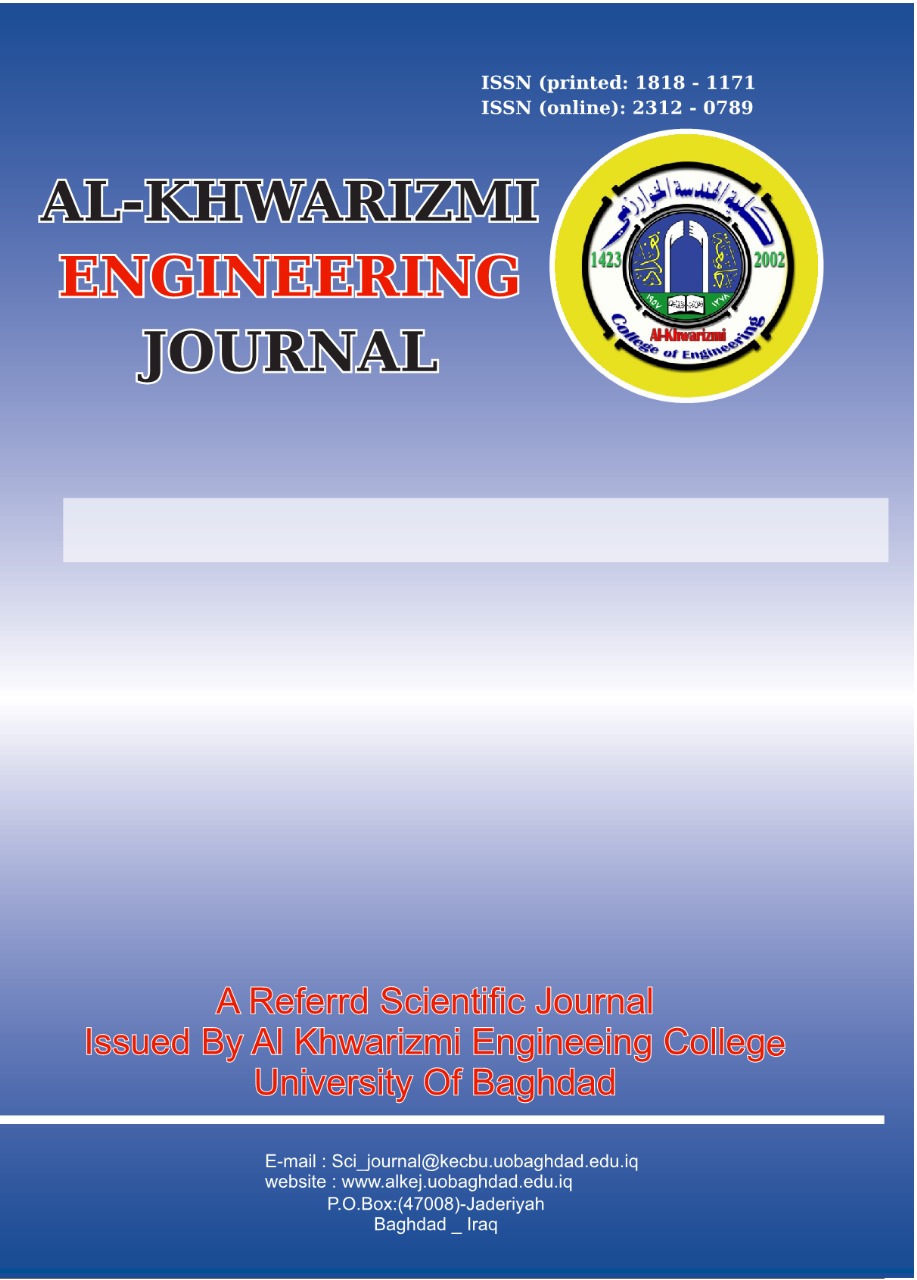Performance Prediction in EDM Process for Al 6061 Alloy Using Response Surface Methodology and Genetic Algorithm
DOI:
https://doi.org/10.22153/kej.2022.08.001Abstract
The Electric Discharge (EDM) method is a novel thermoelectric manufacturing technique in which materials are removed by a controlled spark erosion process between two electrodes immersed in a dielectric medium. Because of the difficulties of EDM, determining the optimum cutting parameters to improve cutting performance is extremely tough. As a result, optimizing operating parameters is a critical processing step, particularly for non-traditional machining process like EDM. Adequate selection of processing parameters for the EDM process does not provide ideal conditions, due to the unpredictable processing time required for a given function. Models of Multiple Regression and Genetic Algorithm are considered as effective methods for determining the optimal processing variables of Electrical Discharge Machining.
The material removal rate (MRR) and tool wear (Tw) were investigated using the process variables of pulse on time (Ton), pulse off time (Toff), and current intensity (Ip). The established empirical models were used to perform Genetic Algorithm (GA) to maximize (MRR) and minimize (Tw). The optimization results were utilized to establish machining conditions, validate empirical models, and obtain optimization outcomes. The optimal result that appears in this work was the pulse on (176.261 μs), pulse off (39.42 μs), and current intensity (23.62 Amp.) to maximize the MRR to (0.78391 g/min) and reduce tool wear to (0.0451 g/min).
Downloads
References
A. Elanthiraiyan, G. Antony, S. Ashok and S. Sathiyaraj,"Investigation of Machining Characteristics of Aluminum 8011 by Wire Cut EDM Process", Int. J. Chem. Sci.: 14(4), 3119-3130, 2016.
R. Sharma, P. Katyal, V. Gill, M. Gupta,"A Research on Investigating the Optimization of Process Parameters of Aluminum Alloy 6061 by using Wire EDM", IJRASET, ISSN: 2321-9653, 6 (II), 2018.
P. Srinivasa, K. Ramji and B. Satyanarayana, "Surface integrity of wire EDMed aluminum alloy: A comprehensive experimental investigation", journal of King Saud University – Engineering Sciences, 30 (4O), 368–376, 2016.
S. Marichamy, B. Stalin, M. Ravichandran and G. Sudha, "Optimization of machining parameters of EDM for α-β brass using response surface methodology", Materials Today: Proceedings 24, 1400–1409, 2020.
S. Kalpakjian, S. Schmid, Manuf. Eng.& Technology, 7th Edition, Ch. 27, Pearson, 2014.
S. Ranjith, V. Srinivasan, S. Balamurugan, S. Dinesh, V. Gokul and S. Anudeep,"Optimization of machine machining parameters in EDM of siliconnitride-titanium nitride based on RSM", Materials Today: Proceedings,2020.
H. Nguyen, N. Ngo and Q. Nguyen, "Optimizing process parameters in edm using low frequency vibration for material removal rate and surface roughness", Journal of King Saud University – Engineering Sciences, 2020.
M. Singh and S. Maharana, "Investigating the EDM parameter effects on aluminium based metalmatrix composite for high MRR", Materials Today: Proceedings, 2020.
M. Singh, H. Kumar, S. Maharana, A.Yadav, R. Singh, P. Maharana, T. Nguyen, S. Yadavand M. Loganathan, "An Experimental Investigation on the Material Removal Rateand Surface Roughness of a Hybrid Aluminum Metal Matrix Composite (Al6061/SiC/Gr) ", Metals, 11, 1449, 2021.
C. Kar, B.Surekha, H. Jena, and S. Dev,"Study of Influence of Process Parameters in Electric Discharge Machining of Aluminum – Red Mud Metal Matrix Composite", 2nd International Conference on Materials Manufacturing and Design Engineering, Procedia Manufacturing 20, 392–399, 2018.
R. Kumar, S. Roy, P. Gunjan, A. Sahoo, D. Deb andR. Kumar,"Analysis of MRR and Surface Roughness in Machining Ti-6Al-4V ELI Titanium Alloy Using EDM Process", 2nd International Conference on Materials Manufacturing and Design Engineering, Procedia Manufacturing 20, 358–364, 2018.
S. Sapkal and P. Jagtap,"Optimization of Micro EDM Drilling Process Parameters for Titanium Alloy by Rotating Electrode", 2nd International Conference on Materials Manufacturing and Design Engineering, Procedia Manufacturing 20, 119–126, 2018.
R.Rajeshand M. Dev Anand, "optimization of the Electro-Discharge Machining Process Using Response Surface Methodology and Genetic Algorithms", ICMOC, Procedia Engineering, 38, 3941 – 3950, 2012.
Tzeng, CJ.and Chen, RY., "Optimization of electric discharge machining process using the response surface methodology and genetic algorithm approach", IJPEM, 14, 709–717, 2013.
V. Devkumar, E. Sreedhar and M.P. Prabakaran, "Optimization of machining parameters on AL 6061 alloy using response surface methodology", IJAR, 1 (7), 01-04, 2015.
R. Myers, D. Montgomery and C. Anderson-Cook, Response surface methodology process and product optimization using designed experiments, John Wiley & Sons Publication, 3rd Edition, 2009.
M. Tiwan, K. Mausam, K. Sharma, R. Pratap,"Investigation the optimal Combination of Process Parameters for EDM by Using a Grey Rational Analysis", AMME, 2014.
R. Rudrapati, P. Sahoo and A. Bandyopadhyay, "Optimization of process parameters in CNC turning of aluminium alloy using hybrid RSM cum TLBO approach", IOP Conf. Series: Materials Science and Engineering, 2016.
P. Jayaraman, L. Mahesh and V. Senthil, "Optimization of Cutting Parameters in Turning of AA6351 Using Response Surface Methodology and Genetic Algorithm", IJAER, 10 (23), 43905-43911,2015.
Downloads
Published
Issue
Section
License
Copyright: Open Access authors retain the copyrights of their papers, and all open access articles are distributed under the terms of the Creative Commons Attribution License, which permits unrestricted use, distribution, and reproduction in any medium, provided that the original work is properly cited. The use of general descriptive names, trade names, trademarks, and so forth in this publication, even if not specifically identified, does not imply that these names are not protected by the relevant laws and regulations. While the advice and information in this journal are believed to be true and accurate on the date of its going to press, neither the authors, the editors, nor the publisher can accept any legal responsibility for any errors or omissions that may be made. The publisher makes no warranty, express or implied, with respect to the material contained herein.
















